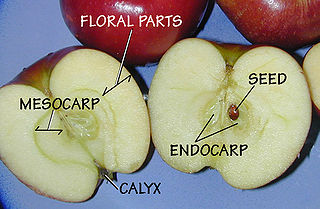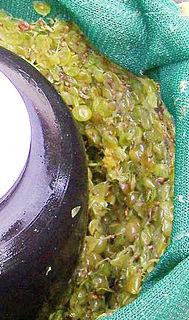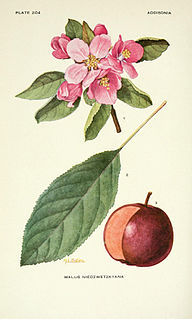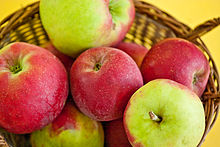
The McIntosh, McIntosh Red, or colloquially the Mac, is an apple cultivar, the national apple of Canada. The fruit has red and green skin, a tart flavour, and tender white flesh, which ripens in late September. In the 20th century it was the most popular cultivar in Eastern Canada and New England, and is considered an all-purpose apple, suitable both for cooking and eating raw. Apple Inc. employee Jef Raskin named the Macintosh computer line after the fruit. John McIntosh discovered the original McIntosh sapling on his Dundela farm in Upper Canada in 1811. He and his wife cultivated it, and the family started grafting the tree and selling the fruit in 1835. In 1870, it entered commercial production, and became common in northeastern North America after 1900. While still important in production, the fruit's popularity fell in the early 21st century in the face of competition from varieties such as the Gala. According to the US Apple Association website it is one of the fifteen most popular apple cultivars in the United States. A mutant(sport) of McIntosh is McIntosh Rogers, synonyms: Red Mc Intosh, Double Red Mc Intosh. This mutant was found in Dansville, New York, USA in 1930.

In botany, blossoms are the flowers of stone fruit trees and of some other plants with a similar appearance that flower profusely for a period of time in spring.

Guava is a common tropical fruit cultivated in many tropical and subtropical regions. The common guava Psidium guajava is a small tree in the myrtle family (Myrtaceae), native to Mexico, Central America, the Caribbean and northern South America. Related plants may also be called guavas; they belong to other species or genera, such as the pineapple guava, Feijoa sellowiana. In 2019, 55 million tonnes of guavas were produced worldwide, led by India with 45% of the total. Botanically, guavas are berries.

The quince is the sole member of the genus Cydonia in the family Rosaceae. It is a tree that bears a deciduous pome fruit, similar in appearance to a pear, and is bright golden-yellow when mature. The raw fruit is a source of food. The tree has been grown by landscape architects for its attractive pale pink blossoms and other ornamental qualities.

In botany, a pome is a type of fruit produced by flowering plants in the subtribe Malinae of the family Rosaceae. Well-known pomes include the apple, pear, and quince.

Pomace, or marc, is the solid remains of grapes, olives, or other fruit after pressing for juice or oil. It contains the skins, pulp, seeds, and stems of the fruit.

Jonagold is a cultivar of apple which was developed in 1953 in New York State Agricultural Experiment Station of Cornell University's College of Agriculture and Life Sciences, a cross between the crisp Golden Delicious and the blush-crimson Jonathan; the name Jonagold is a portmanteau of these two variety names. They form a large sweet fruit with a thin skin. Because of their large size they are now favoured by commercial growers in many parts of the world. Jonagold is triploid, with sterile pollen, and as such, requires a second type of apple for pollen and is incapable of pollenizing other cultivars. The Jonagored Apple, a sport mutation of Jonagold, was once covered under United States Patent PP05937, now expired.

Gala is a clonally propagated apple cultivar with a mild and sweet flavour and striped or mottled appearance. In 2018, it surpassed Red Delicious as the apple cultivar with the highest production in the United States, according to the US Apple Association. It was the first time in over 50 years that any cultivar was produced more than Red Delicious.

The 'Pink Pearl' apple is a pink-fleshed apple cultivar developed in 1944 by Albert Etter, a northern California breeder. It is a seedling of 'Surprise', another pink-fleshed apple that is believed to be a descendant of Malus niedzwetskyana.

Cripps Pink is a cultivar of apple. It is one of several cultivars sold under the trade mark name Pink Lady. Cripps Pink was originally bred by John Cripps at the Western Australia Department of Agriculture by crossing the Australian apple Lady Williams with a Golden Delicious; the result is a combination of the firm, long-storing property of Lady Williams with the sweetness and lack of storage scald of Golden Delicious.

Syzygium malaccense is a species of flowering tree native to Malesia and Australia. It is one of the species cultivated since prehistoric times by the Austronesian peoples. They were carried and introduced deliberately to Remote Oceania as canoe plants. In modern times, it has been introduced throughout the tropics, including many Caribbean countries and territories.

An apple is an edible fruit produced by an apple tree. Apple trees are cultivated worldwide and are the most widely grown species in the genus Malus. The tree originated in Central Asia, where its wild ancestor, Malus sieversii, is still found today. Apples have been grown for thousands of years in Asia and Europe and were brought to North America by European colonists. Apples have religious and mythological significance in many cultures, including Norse, Greek, and European Christian tradition.

The atemoya, Annona × atemoya, or Annona squamosa × Annona cherimola is a hybrid of two fruits – the sugar-apple and the cherimoya – which are both native to the American tropics. This fruit is popular in Taiwan, where it is known as the "pineapple sugar apple" (鳳梨釋迦), so is sometimes wrongly believed to be a cross between the sugar-apple and the pineapple. In Cuba it is known as anón, and in Venezuela chirimorinon. In Israel and Lebanon, the fruit is called achta, but in Israel it is more common to call the fruit annona as Latin. In Tanzania it is called stafeli dogo. In Brazil, the atemoya became popular and in 2011, around 1,200 hectares of atemoia were cultivated in Brazil.

'Beauty of Bath' is a dessert apple cultivar.

Chelmsford Wonder is a cooking apple cultivar.

Malus niedzwetzkyana, or Niedzwetzky's apple, is a kind of apple native to certain parts of China, Afghanistan, Kazakhstan, Kyrgyzstan, and Uzbekistan noted for its red-fleshed, red-skinned fruit and red flowers. Some botanists consider it a distinct species, while others have argued it is simply an unusual variety of the common apple, Malus pumila.

'Surprise' is a pink-fleshed apple that is the ancestor of many of the present-day pink/red-fleshed apples bred by American growers.
Applecrabs are various hybrids between crabapples and apples. They are bred for varying reasons, including disease resistance and use in cold climates because they are often hardier than apple trees and their fruit has the good eating qualities of apples.

Åkerö, also called Akero or Okera, is an old apple cultivar of presumed Swedish origin, but possibly introduced from the Netherlands. It is a dessert apple with an aromatic flavor.

'Splendour' or 'Splendor' or 'Starksplendor' is a modern cultivar of domesticated apple which was developed in New Zealand, and is regarded there as a popular commercial dessert apple. It has been said to be a cross between 'Red Dougherty' and 'Golden Delicious', but genetic analysis has not definitely characterized either of the parent cultivars, and records do not indicate known or suspected parents.




















